November is just one part of the seasons of the year that enfold God’s creation.
November is also a time of transition.
 Culturally, it is bland, squeezed between the excitement of Halloween in October and the joy of Christmas in December, but if we look at it from a different perspective, it is filled with opportunities for growth that comes from change.
Culturally, it is bland, squeezed between the excitement of Halloween in October and the joy of Christmas in December, but if we look at it from a different perspective, it is filled with opportunities for growth that comes from change.
Where we live, in November, leaves that have finished turning brilliant colors of red, yellow, and orange fall from the trees, carpeting the ground. They serve to insulate tender plants and feed earthworms and good microbes, especially as the leaves decompose.
Colder weather means summer clothes are packed away, and winter clothes take their place. The smell of logs burning in a fireplace may bring the cozy feeling of hearth and home.
We look forward to the flavors of pecan pie, caramel apples, and, for some, pumpkin everything. Ice cream treats are replaced with hot cocoa and whipped cream. Winter produce finds its way to our table, especially, if we are blessed, the Thanksgiving table.
For Catholics, November is also the transition from ordinary time to Advent, the end of one liturgical year and the beginning of another. This is a wonderful opportunity to explain or reinforce the meaning of the liturgical calendar with students.
November is also the month of remembering – All Saints Day, All Souls Day, and the holy lives of individual saints are celebrated during the month. The liturgical calendar this month is full of memorials, feasts, and solemnities.
Though Thanksgiving is not a religious holiday, giving thanks for all of God’s blessings is an important part of the Catholic faith and something that nurtures faith development in children.
Helping children see and understand the need for transition or change is an important task, as children often find change difficult. But learning to process change well leads to the ability to be flexible and to adjust to the changes and transitions life will present to them. Helping children find reasons for thanksgiving in the midst of change is an important stepping stone of faith.
November in the religious education classroom could include:
Create a November welcome – The classroom environment sets the mood for learning. Use materials from nature to both decorate and foster discussion about the wonder of God’s creation. Include a quote from Pope Francis on a bulletin board, such as this one which includes gratitude: “This is the time to re-acquaint ourselves with praying immersed in nature, where our gratitude to the creator God arises spontaneously.” Encourage students to share reasons for November gratitude.
Update the Prayer Corner—As the liturgical calendar comes to an end, with November 27 this year being the first day of Advent, drawing students’ attention to the prayer corner, its colors, and items placed in that corner or on that table, will help highlight the change that happens for the Advent season – the green of ordinary time replaced with purple, traditionally symbolizing fasting and penance as we prepare our hearts for the birth of Jesus at Christmas. This is a good time to engage students in discussions about how they may get ready for Jesus in their hearts.
Review your teachers’ manuals –Information on the liturgical year may appear in various chapters of your manual. Use what you feel is appropriate for your class in November. You may also find information on liturgical colors at Understanding the Liturgical Colors | USCCB and liturgical calendar at Liturgical Year and Calendar for the Dioceses of the United States | USCCB.
Write November poems – Poems about the seasons have always been popular with writers and poets, though many November poems focus on the dark and dreary parts of the month – cold and windy days, early darkness, and barren trees. Encourage your students to find reasons in November to be grateful and celebrate. The poem below is a good example, though I might have used the almost last line as the title – God’s treasures in a row.
Twelve Months in a Row
by Annette Wynne
Twelve months in a row,
Use them well and let them go;
Welcome them without a fear,
Let them go without a tear—
Twelve months in a year;
Greet the passing miracle,
Spring and summer beautiful,
Autumn, winter, gliding on,
Glorious seasons quickly gone—
God's treasures in a row,
Take them, love them, let them go!
 About the Author
About the AuthorMary Clifford Morrell, mother of six and grandmother to ten, is a Catholic journalist, editor, and author who has served the Dioceses of Metuchen and Trenton, New Jersey; Burlington, Vermont, and RENEW International in the areas of religious education and communication.
The American celebration of Thanksgiving lasts but a day (or until all the turkey leftovers are gone). We often measure the importance of that celebration by how many of our loved ones could attend, the size of the turkey, or the appearance of our favorite casserole or pies. In other words, it’s about the meal – as it should be. On this holiday, we acknowledge that those blessings come from God.
 Help your students see how their families’ Thanksgiving meal is a reminder of the Sacrament of the Eucharist. The Greek word “Eucharist” actually means “thanksgiving.” The Catechism of the Catholic Church tells us that, among other things, the Holy Eucharist is “an action of thanksgiving to God.”
Help your students see how their families’ Thanksgiving meal is a reminder of the Sacrament of the Eucharist. The Greek word “Eucharist” actually means “thanksgiving.” The Catechism of the Catholic Church tells us that, among other things, the Holy Eucharist is “an action of thanksgiving to God.”
The Eucharistic Prayer at Mass, which begins when the priest extends his arms and says, “The Lord be with you… lift up your hearts… let us give thanks to the Lord our God…” is the center and high point of the Mass. It is truly a thanksgiving prayer, the Church’s great “grace before meals.”
Prepare for Thanksgiving Day in the Classroom. Ask students to make a list of at least five things or people they are thankful for. Then ask, “What are we thanking God for when we go to Mass and receive Holy Communion?”
Engage Families. While it's not a Holy Day of Obligation, going to Mass is a meaningful way to start the Thanksgiving holiday. Once the turkey is in the oven, the cooks could have a few hours to spare.
The festive family meal lends itself to prayer at home, as well. Some families like to go around the table with each person saying what they're thankful for from the previous year. Send home this Prayer for Thanksgiving.
Families will also enjoy My Mass Book, a colorful tool for parents that includes tips for teaching about the meaning of the Mass.
Art Project. Some families like to include appropriate Scripture readings as they sit down to dinner and say grace before the meal. Dozens of Scripture verses highlight God's expectation of our thankfulness. Invite students to make and decorate place cards for the Thanksgiving table with Scripture verses that speak of gratitude and thankfulness. Some examples:
- 1 Thessalonians 5:18. "Give thanks in all circumstances; for this is the will of God in Christ Jesus for you."
- Psalm 86:12. "I give thanks to you, O Lord my God, with my whole heart, and I will glorify your name forever."
- Philippians 4:6. "Do not be anxious about anything, but in everything…let your requests be made known to God."
- Psalm 106:1. "Praise the Lord. Give thanks to the Lord, for he is good; his love endures forever."
Resources for Liturgical Catechesis. Your Blest Are We Faith in Action program includes a strong liturgical component in each grade level. The second chapter of each unit focuses on the liturgical prayer of the Church, including the Sacraments. In addition, the Hear and Believe section of these lessons usually includes text from the Mass or one of the rites.
 About the Author
About the AuthorDr. Lauri Przybysz specializes in equipping families to live their vocation to be domestic churches and signs of God’s love. Lauri received the Doctor of Ministry from the Catholic University of America, and she has been both a Catholic middle school religion teacher and a faith formation coordinator at the archdiocesan and parish levels. She is the mother of six children and grandmother of 21.
Product Highlights
My Mass Book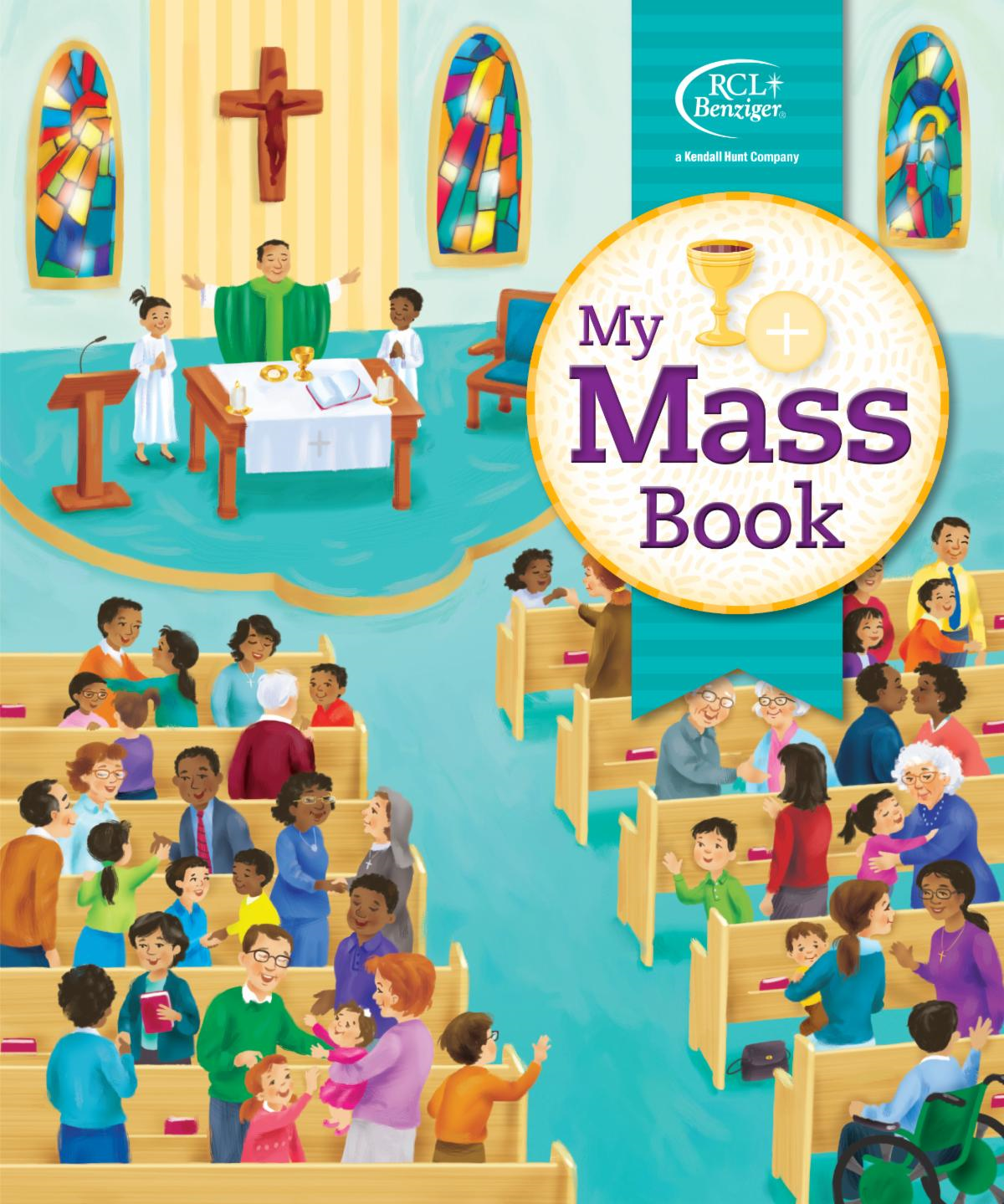
Recommended for children ages 6-9, this colorfully-illustrated and portable book helps children pray with the whole family of God at Mass and with their families in the Church of the home. It includes The Order of Mass, its prayers and responses, Catholic Prayers and Practices, including a visit to the church, symbols of the Church, the liturgical year, an examination of conscience, the Rosary, the Stations of the Cross, and other traditional Catholic prayers.
Our Family Prays 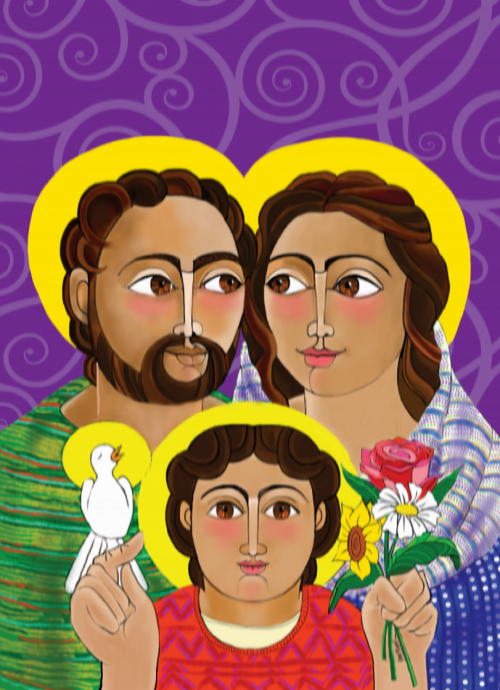
Our Family Prays is a collection of rituals, blessings, prayers, and traditions meant to encourage and inspire Catholic families to keep prayer at the heart of their homes. It is organized by the seasons of the liturgical year and includes religious traditions and celebrations from around the world.
After two years of not being able to gather together, it was a joy, this year, to attend a Lenten morning of recollection led by renowned artist Oblate of Saint Francis de Sales Brother Mickey McGrath. Brother Mickey took us through the Stations of the Cross, using his own inspired artwork, helping us connect the stations to our own experiences and what is happening in the world today.
 He also shared his outreach to youth, providing them with occasions to join him in creating art as part of their spiritual journey, opportunities the youth acknowledge as powerful learning experiences in faith.
He also shared his outreach to youth, providing them with occasions to join him in creating art as part of their spiritual journey, opportunities the youth acknowledge as powerful learning experiences in faith.
There are many ways in which children learn and come to faith. Among the most effective is engagement in the creative process, using their imaginations and their own experiences. This can be heightened by learning within a community, like the Catholic school classroom.
As we move through Lent and begin planning for Holy Week, there is a wealth of Catholic teaching, liturgies, devotions and celebrations that may be incorporated into a creative lesson that would lend itself to a mini-retreat in the classroom. Additional Activities and Enriching the Lesson sections from the Blest Are We teacher’s guides offer helpful ideas for engaging students, depending on their ages, in themes of forgiveness, charity, fasting and self-discipline, Stations of the Cross, Holy Thursday, especially as it relates to Mass, Good Friday, and Holy Saturday.
A Mini-Retreat
Begin and end with prayer: Refer to religion textbooks for appropriate prayers, or choose a favorite Psalm or prayer with which children are familiar.
Prepare music: A background of inspirational music is helpful in lending a prayerful element to the experience while children are working.
As Inspiration: Prepare a black or white board with words or symbols denoting Lenten practices, like forgiveness or charity, and invite students to add related words to fill the board, or if time is very limited, add additional words yourself. Students may use these words to portray their own understanding of a theme or topic in a chosen art form:
- God Letters – Children often feel like they are not being heard. Writing a letter to God gives them an opportunity to be honest before God about their joys, reasons for gratitude and their fears.
- Stained Glass “Windows” – These windows have an important history in the Church as a means of religious education for those who were not literate. The images enabled all the faithful to have a better understanding of the Gospel and the life of Christ. Have children draw a religious symbol or word of their choice (hearts included) in the center of drawing paper, outlining it in black and coloring; divide the rest of the page into random sections also outlined in black; color sections in bright colors.
- My Own Vespers – Vespers, or evening prayer, are part of the Liturgy of the Hours. They have been prayed for centuries, often by monks who prayed the Psalms of the Old Testament. It is helpful if children are familiar with the Psalms, but even if they are not, children may be encouraged to create their own evening prayer to be said before the end of every day.
- Poems of Faith – Among the saints of the Church are a good number of poets, including St. Thérèse of Lisieux and St. Hildegard of Bingen. Most classrooms also include a budding poet or two. Children who write poems may also want to illustrate the poems as meaningful for them.
Plan to display the work of children, if they are agreeable.
For additional ideas and information, visit RCL Benziger’s free, downloadable Lenten resources and Saints Resource.
 About the Author
About the AuthorMary Clifford Morrell, mother of six and grandmother to ten, is a Catholic journalist, editor, and author who has served the Dioceses of Metuchen and Trenton, New Jersey; Burlington, Vermont, and RENEW International in the areas of religious education and communication.
Product Highlight
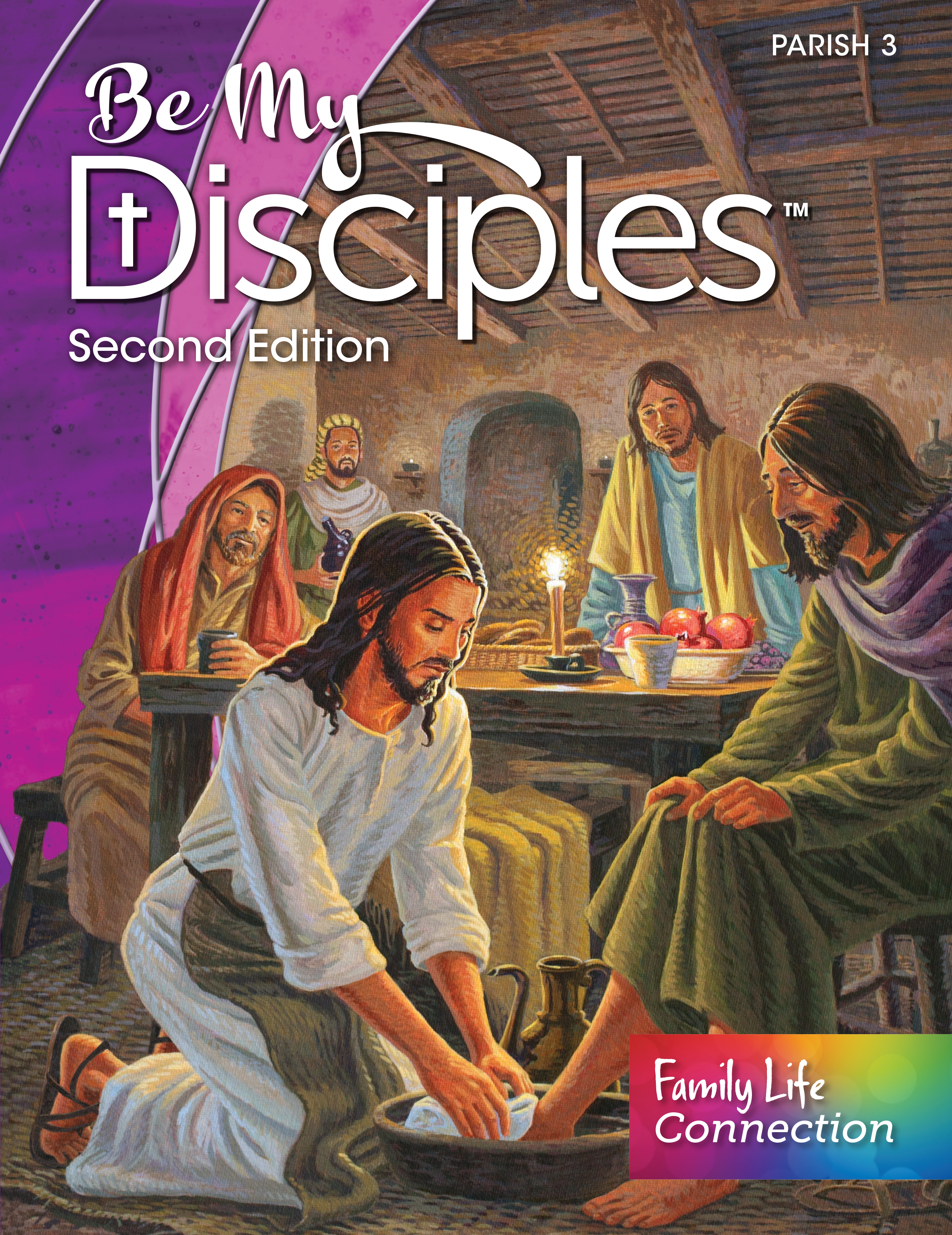 Be My Disciples Second Edition
Be My Disciples Second Edition
This new Parish Program for grades 1-6 now includes the Family Life Connection, an amazing family resource built right into the Student Edition textbook! Students will take home this two-page insert to help them build the skills they need to live healthy, holy lives. This newly updated and expanded edition encourages children to understand their role within the parish community and continue to grow in their identity as sons and daughters of God.
Jesus has taught us the perfect way to pray in the Lord’s Prayer, found in similar forms in the Gospels of Luke (Ch. 11) and Matthew (Ch. 6). The disciples could see that prayer was an important part of his life. They must have noticed something about the way he prayed that was different. It made them want to learn how to pray as he did. Luke tells us that Jesus was “full of joy through the Holy Spirit” when he prayed. (Luke 10:21a). Prayer refreshed and renewed him.
 Saint Augustine (A.D. 354-430) described the Lord’s Prayer this way: “Run through the words of the holy prayers [in Scripture], and I do not think that you will find anything in them that is not contained in the Lord’s Prayer.” We pray this prayer at every Mass. It is the tradition of the Church to pray the Lord’s Prayer three times a day. Think about when you could add the Lord’s Prayer one extra time during the school day with your students.
Saint Augustine (A.D. 354-430) described the Lord’s Prayer this way: “Run through the words of the holy prayers [in Scripture], and I do not think that you will find anything in them that is not contained in the Lord’s Prayer.” We pray this prayer at every Mass. It is the tradition of the Church to pray the Lord’s Prayer three times a day. Think about when you could add the Lord’s Prayer one extra time during the school day with your students.
The Lord’s Prayer illustrates the order in which we should pray: Praise; Petition; Sorrow; Reliance of God totally. If we do this, our relationship with God will be in right order and so will your priorities. Your Blest Are We Faith in Action revisits the Lord’s prayer in every grade. Look in the Table of Contents in your Teacher Edition for more ways to teach and pray the Lord’s Prayer.
We Examine Our Actions. Reflecting on the Lord’s Prayer is especially appropriate when your students are preparing to go to Confession. It has all the various kinds of prayer in one: God’s name is glorified, his plans for creation be fulfilled, we realize how God cares for us and gives us what we need, our daily bread and forgiveness of our sins. We pledge to forgive others, confident that God will defend us from harm.
From Trespasses to Treats. After praying the Lord’s Prayer, ask students to name some ways that someone might trespass against another person. After making a list of their ideas, ask students for ways they would want to be treated instead. For example: A trespass could be excluding someone from a game; the treat could be to invite them to play. Another example, a gossiping about someone is a trespass; it would be a treat to say what you like about the person.
Putting Prayer in Motion. We can pray with our bodies as well as our voices. For example, we genuflect silently to offer God praise. We make a Sign of the Cross. Invite students to act out the Lord’s Prayer. Ask students, “If you wanted to pray the Our Father without using words, how would you dramatize “heaven,” “daily bread,” "forgiving,” or “deliver us”? You could even add music to the prayer demonstration.
Explore more ideas for classroom prayer in the free Catholic Resources.
Product highlights:
- Catholic Prayers and Practices for Young Disciples (English)
- Catholic Prayers and Practices (English)
- Our Family Prays - Catholic Prayers & Traditions (English)
 About the Author
About the AuthorDr. Lauri Przybysz specializes in equipping families to live their vocation to be domestic churches and signs of God’s love. Lauri received the Doctor of Ministry from the Catholic University of America, and she has been both a Catholic middle school religion teacher and a faith formation coordinator at the archdiocesan and parish levels. She is the mother of six children and grandmother of 21.
Parents and grandparents often share with me that they pick up on language, gestures and attitudes among their children that are not coming from home. They are, they say, coming from social media videos, and the influencers who have become almost daily guests in the lives of many of today’s children.
 Two of the top video influencers for youth have more than 100 million followers each, but that doesn’t diminish the influence of those who have followers only in the thousands. And for the most part, the influence isn’t positive.
Two of the top video influencers for youth have more than 100 million followers each, but that doesn’t diminish the influence of those who have followers only in the thousands. And for the most part, the influence isn’t positive.
Experts in the field identify fame, materialism, self-absorption, legitimizing disrespect and an often-negative impact on body image as the downside of social media influencers, most of who are battling for the spotlight even at a very young age.
As the adults who play an important role in the lives of children, we need to be aware of just who is influencing our children and what they are learning from the latest cultural icons, many of whom are young people like our children, a fact which makes them very relatable.
Fortunately, as Catholics, we have our own influencers who can make a positive impact on our youth. We just need to bring them into our young people’s field of vision.
Let’s start with Blessed Carlo Acutis, destined to be our first millennial saint, who used technology to bring youth closer to God.
Speaking of Carlo, Pope Francis said, “The digital world can expose you to the risk of self-absorption and isolation. But there are young people even there who show creativity and even genius. Like Carlo.”
Carlo, who was known by some as a computer geek, lived the life of a normal teen in the 21st century, enriched by his search for holiness. He went to school, studied, played soccer and served in soup kitchens. He enjoyed films and video games and volunteered after school with the homeless and poor. He also went to daily Mass and was devoted to the Eucharist, spending four years using his computer skills to build a website to tell the stories of Eucharistic miracles from around the world.
One thing, Carlo never desired was fame. He worked humbly for the good of others and out of love for God. In 2006, when Carlo was fifteen, he became seriously ill and was soon diagnosed with leukemia. Ten days after taking ill, he died.
Carlo was beatified in 2020. His feast day is Oct. 12. He is just one of a number of young saints with whom are youth might identify, and from whom they may learn that holiness does not require that they give up who they are as contemporary youth, but means, instead, evaluating what is good for them, good for others and good for their relationship with God.
Bishop David M. O’Connell, C.M., of the Diocese of Trenton, N.J., has written a series entitled “Young Saints.” In his message, addressed to youth, he writes, “Becoming a saint starts now ... you don’t have to wait until you ‘grow up.’ If you want to be a good person, a holy person, “Why wait?”
“Like anything else in life, being good at something takes practice, a lot of practice. That’s true of a career. That’s true of healthy, loving relationships. That’s also true of faith and holiness and ... of becoming a saint!
“We need saints in the world, in our country, in the Church, in school, in families, in our friendships, in work, in what we hope to do and to be ... but not only ‘one day’ or way in the future. We need saints right now! And we need to begin to practice right now!”
In addition to the many opportunities to introduce your children to saints that appear in your curriculum guides, consider familiarizing yourself with those younger saints who, even with difficulties and challenges, were led by their love of God.
 About the Author
About the AuthorMary Clifford Morrell, mother of six and grandmother to ten, is a Catholic journalist, editor, and author who has served the Dioceses of Metuchen and Trenton, New Jersey; Burlington, Vermont, and RENEW International in the areas of religious education and communication.
Product Highlight
Our Family Faith: Resource Guide for Family Catechesis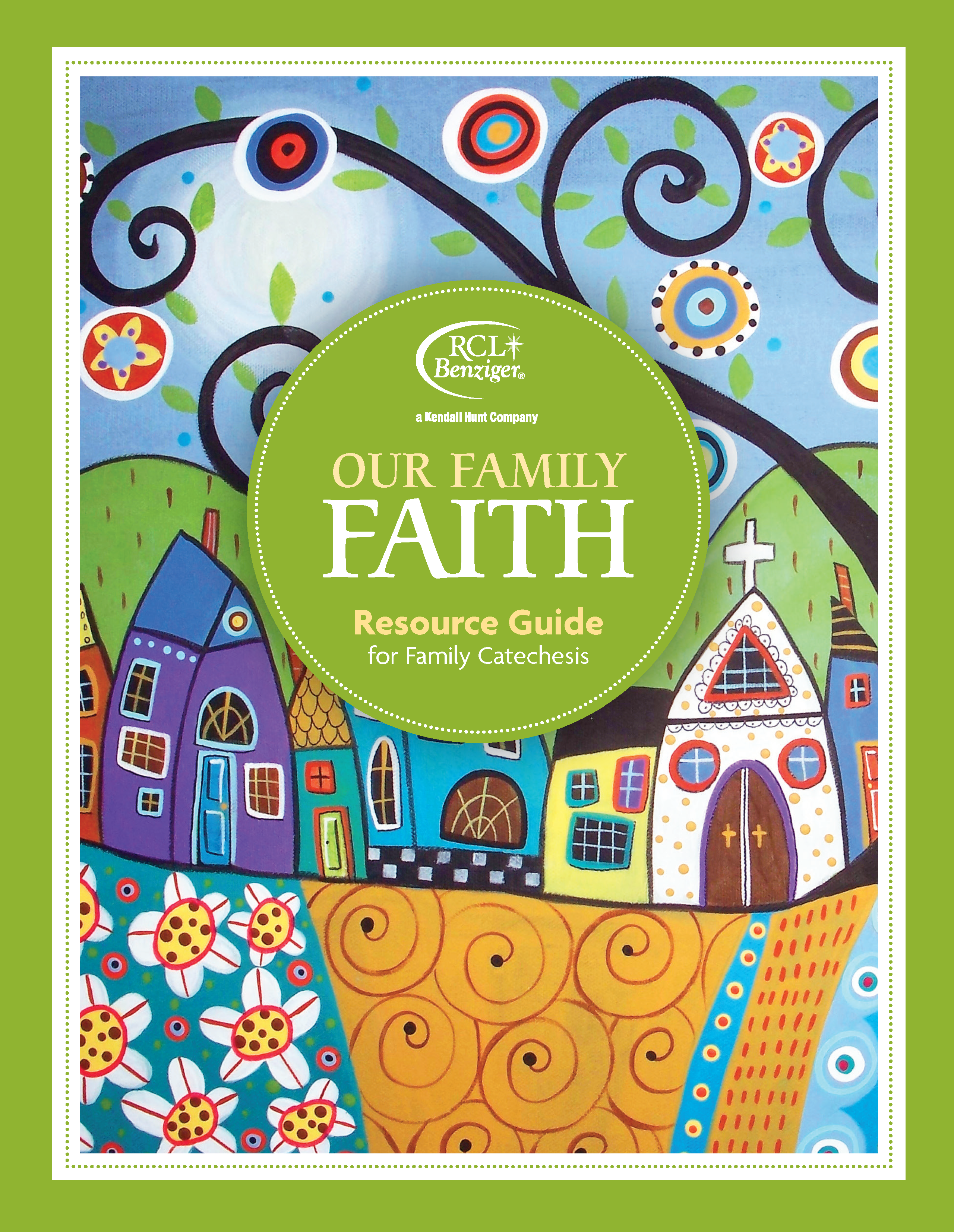
We listened when catechetical leaders asked for faith formation models that better engage families and support parents as the primary catechists of their children. We recognized the need for flexible and customizable resources that are simple, affordable, and effective.
Our Family Faith: Resource Guide for Family Catechesis provides catechetical leaders with the tools needed to engage entire families. Packed with practical suggestions and ready-to-use tools.
In the autumn of the year, as the days get shorter and the darkness comes earlier, it is natural and proper to reflect on our own mortality and remember that we are safe in God’s care. When we take this perspective, we may better understand the Catholic connections of celebrating Halloween on eve of the feast of All Saints, or “hallowed” ones. Our faith reassures us that God is with us to conquer the scary things in life.
 All Saints and All Souls comprise the two-day celebration of the Communion of Saints – those who are with God in heaven and those who are on their way to heaven. These two feasts turn our thoughts into things eternal and our Catholic hope of salvation.
All Saints and All Souls comprise the two-day celebration of the Communion of Saints – those who are with God in heaven and those who are on their way to heaven. These two feasts turn our thoughts into things eternal and our Catholic hope of salvation.
On the Solemnity of All Saints, November 1, the Church venerates all the holy men and women who are in heaven now, praying for us. On this feast, not only can we pray to our favorite saints, but we can also call upon our departed brothers and sisters whom we believe are already with God. In my Catholic school, we enjoyed celebrating All Saints’ Day by dressing up as our favorite saints. The Solemnity of All Saints is a Holy Day of Obligation. Celebrate All Saints Day with your students with this activity. All Saints Day
A day later, on the Commemoration of All the Faithful Departed (All Souls’ Day), the Church remembers and prays for the faithful departed: our brothers and sisters who have died marked with the sign of faith. We pray for them to be fully united with God in heaven. This is also called the Day of the Dead, and families visit the graves of their loved ones to honor them and celebrate their lives. Gather your students for a classroom prayer for deceased loved ones and to affirm our faith in the Resurrection with these prayers. Prayers for the Day of the Dead
At this time of year, you may want to review or share with parents the guidance about Helping Children Cope with Loss, a Catholic Parenting 101 publication by Timothy Hogan, Psy.D., LP, CIRT.
We are a faith family that hopes in God’s love and mercy, during life and after death. The Family Life series, at every grade level, focuses on our relationships at home, The Family Album feature highlight saints from our heavenly “extended family.” They are our role models for a good moral life. Saint Teresa of Calcutta said that “holiness is not the luxury of a few people, but a simple duty for you and me.”
We are all called to become saints, and we can accomplish that by striving to follow God’s commands and being united with him in love. To be holy, to be a saint, means allowing God “to live his life in us,” as Mother Teresa taught. Learn more about Mother Teresa, Saint Dominic, and hundreds of other saints in the Saints Resource.
 About the Author
About the AuthorDr. Lauri Przybysz specializes in equipping families to live their vocation to be domestic churches and signs of God’s love. Lauri received the Doctor of Ministry from the Catholic University of America, and she has been both a Catholic middle school religion teacher and a faith formation coordinator at the archdiocesan and parish levels. She is the mother of six children and grandmother of 21.
Product Highlight
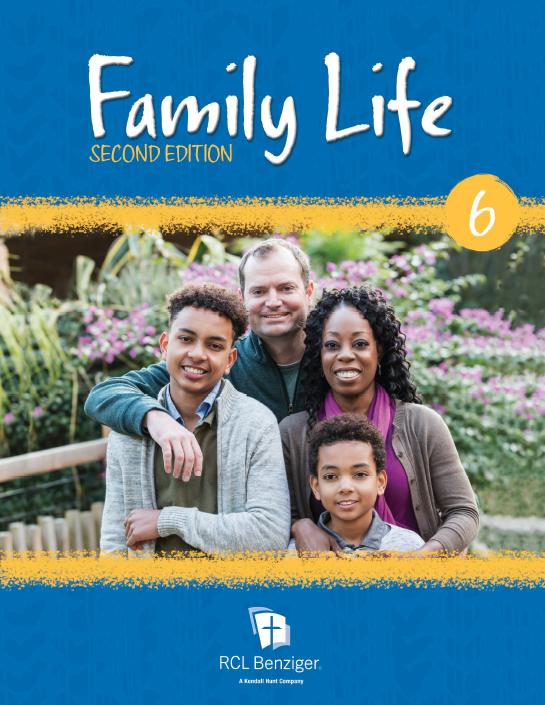 Family Life Second Edition
Family Life Second Edition
Family Life Second Edition is the newly updated edition of RCL Benziger’s leading K-8 supplemental program that addresses key concerns of today’s Catholic families. In every grade level, Family Life includes child safety education, promotes virtuous living, and strengthens Catholic identity.
The Family Life program reinforces the Catholic virtues and values that your students attain with their education. Family Life is an essential component of your school-based religious education program and meets Social and Emotional Learning (SEL) standards and benchmarks.
Many years ago, I was confronted with a question that continues to impact my faith today. The question was written on a sign hanging in a parish office.
“If someone accused you of being a Christian, would there be enough evidence to convict you?”
 At the Last Supper, Jesus told his disciples, “This is how all will know that you are my disciples if you have love for one another.”
At the Last Supper, Jesus told his disciples, “This is how all will know that you are my disciples if you have love for one another.”
A fruit of that love is joy, something we, and our children, don’t hear enough about in our religious education programs. It is not the serious, somber, piety of our faith that draws people to Jesus. It is love – and divine joy.
How often do we see an image of Jesus smiling or laughing? Certainly, it’s not because he didn’t do those things. Those who decided to follow Jesus, in spite of the very strong possibility they could lose their lives in the process, were drawn to a man who possessed a powerful, radiant, inner joy that called to them. His divine joy flowed from his experience of and relationship with God, the Father, and the Holy Spirit.
Looking at the world today, especially in the lives of our young people, Christian joy is often in short stead. The challenges of this culture are a significant part of the reason why two teens, sitting near me in a motel dining room, discussed suffering from anxiety and needing to take medication to sleep. Experts report that even very young children today are suffering from anxiety, sleep deprivation, fear of many things, and emotional overload. Feelings, for many, are in the driver’s seat.
How can we cultivate joy, founded in an encounter with Jesus, in our students so they may go into the world more secure in the love of God?
Praise – The renowned author of the Chronicles of Narnia, C.S. Lewis, wrote, “Praise is the mode of love which always has some element of joy in it.” First Friday Masses and Youth Masses are wonderful opportunities for children to offer praise to God within the liturgy. Frequent opportunities also present themselves in the classroom. Help children find reasons and ways to praise God even when they are feeling poorly. Something simple like, “Thank you, God, for helping me get through today with your love,” can nurture trust in God’s care.
Holy Spirit – In his letter to the Romans, Saint Paul writes, “May the God of hope fill you with all joy and peace as you trust in him, so that you may overflow with hope by the power of the Holy Spirit” (15:13). Many children, and adults, do not understand the Holy Spirit as a separate person of the Trinity, but some people have a devotion to the Holy Spirit as others do to Mary or the saints. Introduce your students to God, the Holy Spirit, in small ways, so they come to understand the Holy Spirit as the one who gives us our gifts of love and joy.
Language – Speak the language of joy. Words matter. Pray Psalm 100 with your class. It is described as a psalm for grateful thanksgiving. It begins (depending on the translation), “Make a joyful noise unto the Lord, serve the Lord with gladness; come before his presence with singing …” Reflect on the words of the full Psalm and ask students how they feel, or what images they see when they pray the Psalm.
Self-reflection – There is no lesson more powerful than the person of the teacher or catechist. Give yourself the gift of time alone with God, to offer praise and prayers for a deeper relationship with the Holy Spirit so Christian joy may be yours to share with your students.
 About the Author
About the AuthorMary Clifford Morrell, mother of six and grandmother to ten, is a Catholic journalist, editor, and author who has served the Dioceses of Metuchen and Trenton, New Jersey; Burlington, Vermont, and RENEW International in the areas of religious education and communication.
Product Highlight
 Be My Disciples Second Edition
Be My Disciples Second Edition
Build a world filled with Christ's Disciples with Be My Disciples. This innovative and complete religious education program empowers children and their families to grow in their relationships with Jesus Christ, develop the habits of discipleship, and decide each day to live as followers of Jesus.
Be My Disciples shares the Christian story through the use of Sacred Scripture and age-appropriate presentation of Sacred Tradition. It forms children to take their place in the midst of the parish community and to continue to grow in their identity as sons and daughters of God. Resources include a wealth of digital resources available for children, parents, catechists, and program directors.
The program leads Catholic children and their families to:
- Grow in their conversion to Jesus Christ
- Develop the habits of discipleship
- Decide each day to choose life in Christ
- Live as active, committed members of the Catholic Church
After spending an afternoon at a concert and following up with a meal and some downtime at a local diner, two of my adult sons returned home expecting to, possibly, see three little munchkins waiting past bedtime to greet their dad and uncle.
What they were surprised to see when they opened the front door was a chicken, a big, brightly colored fowl strutting from the hallway into the living room.
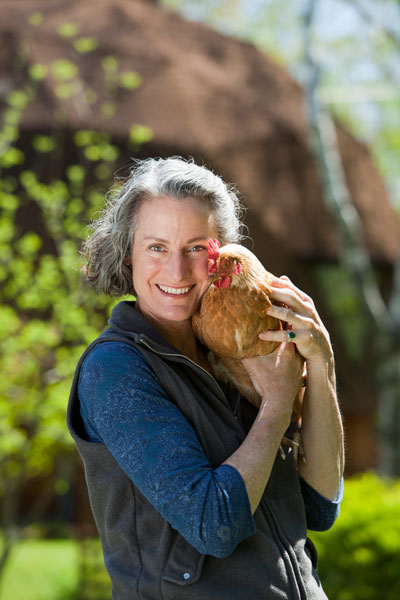
“Did you just see that?” said the younger brother, stopping in the doorway as if questioning his reason. When they left, there were three youngsters, a Golden Retriever, two cats, and two ferrets. No chickens.
“Are you kidding me?” said the older brother, panicked at the prospect. “A chicken? Now we have a chicken??”
After she finished laughing, my daughter-in-law explained that she had borrowed the chicken from a friend to play a joke on my sons and teach her husband a lesson. The lesson being 'things could always be worse!'; apparently, the chicken had the desired outcome.
Creative, effective lessons were Jesus’ forte and methods that are readily available to educators. In addition to telling stories through parables, and asking lots of questions, both of which were previously shared in this blog:
Jesus’ lessons were memorable – Sometimes Jesus surprised people, sometimes he shocked them, but always he presented something important in a way that would be remembered, often with hyperbole – exaggerations, a language with a flair. We see an example in Matt. 7:3-5 when Jesus teaches that we should not sit in judgment of people. He brings the lesson home by using images that are improbable: “How can you say to your brother, ‘Let me remove that splinter from your eye,’ while the wooden beam is in your eye? You hypocrite, remove the wooden beam from your eye first; then you will see clearly to remove the splinter from your brother’s eye.” Another memorable one is, “… it is easier for a camel to go through the eye of a needle than for a rich man to enter the kingdom of God.” Matt. 19:23-24
Jesus used repetition – Jesus understood that if something is memorable and something is repeated, it is something that will be remembered. There’s a reason advertisers repeat the name of a product multiple times in an advertisement, or why the same ads show up repeatedly in our social media and email feeds. Consider how easy it is to match a slogan to a sports company, a fast-food restaurant, or an insurance company. Jesus repeated themes, like the Great Commission, and his death and resurrection many times. He also repeated words and questions. One of the most obvious, and good for classroom discussion, is in John 21:1-19 when Jesus asks Peter three times, “Do you love me?” (15-17).
Jesus used conversation – Jesus’ conversations were personal, facilitated by knowledge of the person with whom he spoke, whether it was someone seeking healing, understanding, or who needed instruction or correction. He shared his concern and his compassion, even when the truth was difficult to hear. One of the most well-known conversations is with the Samaritan woman at the well, John 4: 4-26. We can learn as much as we teach when we help children engage in conversation. Sometimes it’s the youngest child who offers a brilliant insight. Jesus’ greatest skill in conversation was being personally present, with no distractions, and being fully honest, all skills needed for a fruitful conversation with kids or youth.
Spending some time with the Gospels is a wonderful way to learn the teaching methods of Jesus. Look for examples of poetry, puns, object lessons, similes, and metaphors, and, of course, there is a wealth of stories. Make notes as you read and consider how you may add a particular method to a lesson or, perhaps, develop it as part of your teaching style.
 About the Author
About the AuthorMary Clifford Morrell, mother of six and grandmother to ten, is a Catholic journalist, editor, and author who has served the Dioceses of Metuchen and Trenton, New Jersey; Burlington, Vermont, and RENEW International in the areas of religious education and communication.
Product Highlight
OurFamilyFaith.com
The family is where children first experience love, and the home is the first school of discipleship. Supported by Christian communities, families have an essential role in the faith formation of children. RCL Benziger provides resources that recognize the diverse needs of families and Catholic communities and are adaptable to faith formation models based in homes, schools, or parishes.
Looking back on my childhood, I might say I was an eclectic Catholic. My mother was raised Syrian Orthodox, and my father was Roman Catholic. I was baptized Roman Catholic, and we participated in Sunday Mass at St. Teresa of Avila Church near my home. But aside from Mass and C.C.D. classes until fifth grade, I had no sense of belonging to that church.
I felt connected, instead, to the church of my mother and her family, St. George’s Syrian Orthodox Church, though we only went on special occasions. I was entranced by the wall of icons behind the altar, the cantor who sang hauntingly in Arabic, and, of course, enough incense to cloud the small church through the two-hour Mass.
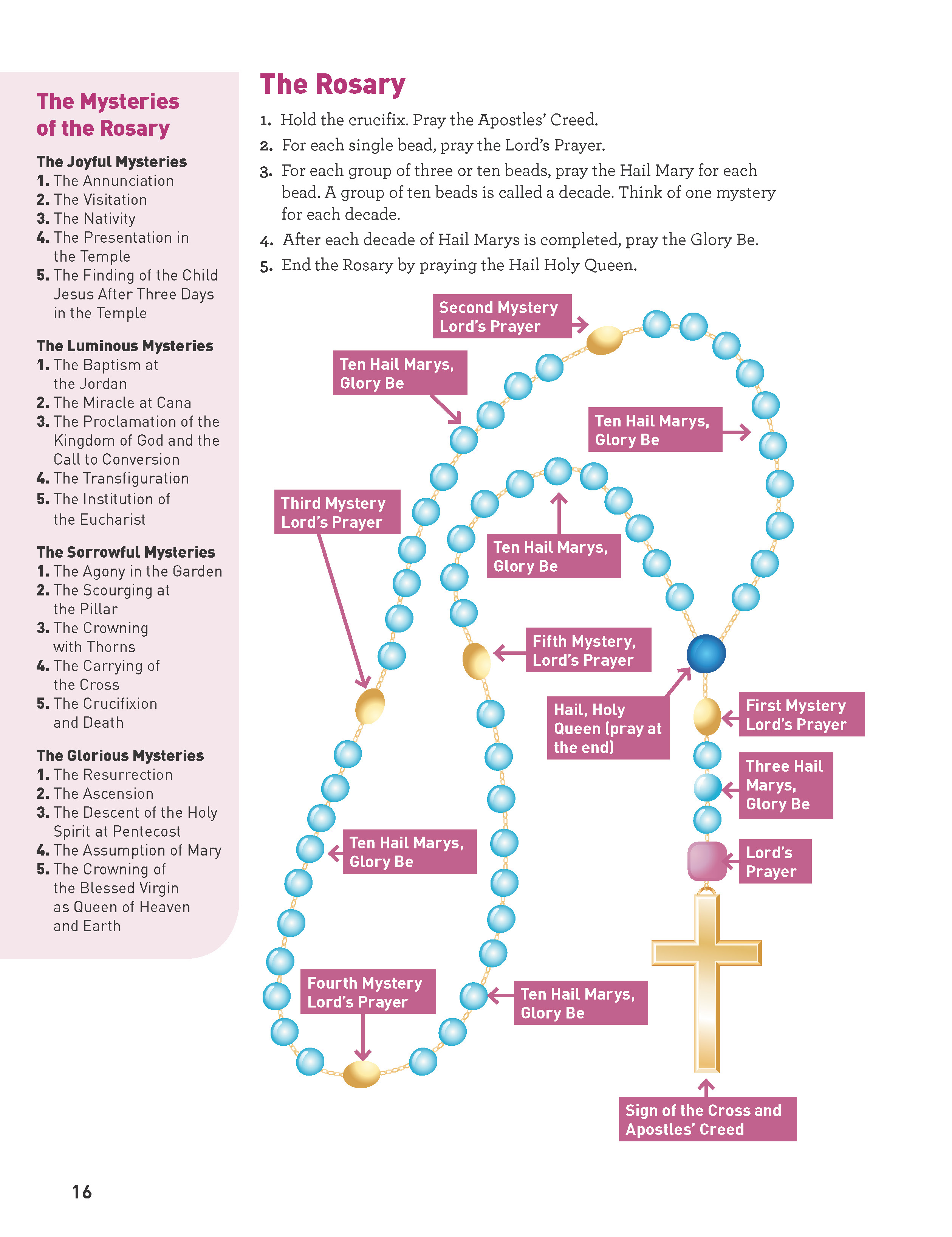 Eucharist was real pieces of fresh Syrian bread and wine from a paper cup, made possible because of a small congregation. We left Mass and gathered in the hall, where there was always food, fellowship, and Arabic music.
Eucharist was real pieces of fresh Syrian bread and wine from a paper cup, made possible because of a small congregation. We left Mass and gathered in the hall, where there was always food, fellowship, and Arabic music.
At some point in my young life, I noticed that many of the men in the congregation carried beads in their hands, almost as if they were an extension of their bodies. They fascinated me, and I wanted some, even though no one ever explained what they were or what you were supposed to do with them.
I finally got them at a funeral repast when a visiting relative from the “old country” smiled at my questions about the beads and handed me his to keep. He told me to pray always.
Back in C.C.D., I learned about the Rosary at some point, but it didn’t “stick.” It wasn’t something we prayed at home, but a family friend traveling to Rome brought me back a Rosary with ivory beads the size of tennis balls. It hung on my wall until I left home after I was married. Now, it’s packed away, a planned gift to one of my younger grandchildren who, I sense, will appreciate it as more than a wall hanging.
So, what’s the point? Religious formation is about connecting with others, community, ritual, and tradition. It’s about the experience beyond the lessons.
October is the Month of the Rosary. It’s a great time to introduce your students to the Rosary or nurture an already existing devotion with additional prayer time. Help them understand the Rosary is more than just a repetition of words. It is a time to reflect on the life of Jesus and Mary and build a relationship with both Mary and her son.
Where to start?
Review your textbooks – Look for sections that cover the Rosary. Most also have diagrams explaining how to pray the Rosary. Familiarize yourself with the steps if the Rosary is not part of your regular prayer. Then review the diagram with your students so they feel more comfortable if it is the first time they’ve used a Rosary or if they don’t pray the Rosary frequently.
Create a Rosary calendar – While praying a full Rosary may be difficult with young children, starting them out early with one decade at a time is manageable and builds a sense of devotion that will, hopefully, stay with them through the difficult teen years and beyond. Add two or three days a week to your classroom calendar for the Rosary. By the end of a month, your students will have prayed the entire Rosary.
Focus on the Mysteries of the Rosary – In addition to praying the Rosary, students will grow in faith and understanding by learning more about the four Mysteries of the Rosary. The Glorious, Joyful, Sorrowful, and Luminous Mysteries, which are all centered on the life of Christ, are a summary of the Catholic faith and another tool for helping children understand what it means to be Catholic.
Make a Rosary – A hands-on experience is always great for kids. Depending on the age of your students, there is a simple craft at Catholicicing.com for a pipe cleaner one-decade Rosary for young children. For older students, check with the parish pastoral associate or the Rosary Altar Society for someone who makes rosary beads and ask them to help students make their own. Rosary-making kits are another option.
Involve the parents – Building a faith community for children may benefit from encouraging parents to participate in faith-related experiences. Whether praying the Rosary, making Rosary beads, or sitting in on a special Mysteries of the Rosary lesson, a parent’s presence can also be an opportunity for faith formation for them. At the end of October, consider a school-wide Rosary and an opportunity for fellowship with students, parents, and school staff.
Remember the words of Pope Francis: "The Rosary is a prayer that always accompanies me; it is also the prayer of the ordinary people and the saints ... it is a prayer from my heart."
 About the Author
About the AuthorMary Clifford Morrell, mother of six and grandmother to ten, is a Catholic journalist, editor, and author who has served the Dioceses of Metuchen and Trenton, New Jersey; Burlington, Vermont, and RENEW International in the areas of religious education and communication.
Product Highlight
 Blest Are We Faith in Action - School Edition Grades K-8
Blest Are We Faith in Action - School Edition Grades K-8
The Blest Are We Faith in Action religious education program engages children, youth, and their families in learning what Catholics believe, how Catholics worship, how Catholics pray, and how Catholics live. Our technology-enhanced learning resources, including eGuides, eBooks, eAssessments, and online chapter reviews, expand learning opportunities for students and flexibility for teachers.
Students will enjoy interactive connections with their textbooks, while teachers will find a variety of useful content for helping students on their formative journey of faith.
- Blest Are We Faith in Action offers:
- Faith in Action pages for each chapter, establishing a strong connection to Catholic Social Teaching
- Redesigned Take Home pages, supporting families in the faith formation of their children
- Increased focus on children with special learning needs, addressing practical ways to adapt lessons
- Training Videos for Teachers, eBooks, eAssessments, Family Resources, Catholic Resources, Saints Resources, Lectionary Resources, and more!
Your school may be part of a parish, or your students may come to your school from a variety of parishes in the region. Aim to foster your students’ involvement in their local parish. Every parish, whether or not they are associated with your school, is called to be a welcoming family that supports your school’s work of catechesis and faith formation.
 "The parish is where the Church lives. Parishes are communities of faith, action, and hope. They are where the Gospel is proclaimed and celebrated, where believers are formed and sent to renew the earth. Parishes are the home of the Christian community; they are the heart of our Church. Parishes are the place where God's people meet Jesus in word and sacrament and come in touch with the source of the Church's life." (Communities of Salt and Light, p. 1)
"The parish is where the Church lives. Parishes are communities of faith, action, and hope. They are where the Gospel is proclaimed and celebrated, where believers are formed and sent to renew the earth. Parishes are the home of the Christian community; they are the heart of our Church. Parishes are the place where God's people meet Jesus in word and sacrament and come in touch with the source of the Church's life." (Communities of Salt and Light, p. 1)
Your ministry as a religion teacher relies on the partnership between your school families and the parishes to which they belong. We know that many families are not well connected with their parishes, however. Although families with students in Catholic schools are more likely to attend Mass regularly, about half of Catholics overall say they attend Mass at least once in a while, including 4% who say they attend weekly, 28% who attend once or twice a month or a few times a year and 15% who say they attend less often. (Pew Research Center, 2015). Since the Covid shutdowns, the numbers have declined even more. We need to do whatever we can to encourage people to re-engage with their parishes.
Play Parish Bulletin Bingo. Here is an activity to strengthen the relationship between your students and their home parishes.
Have students bring a copy of their home parish bulletin to class. Supply copies of your own parish bulletin for anyone who does not bring their own copy or does not have a home parish. Create a bingo card that includes big squares with the following labels and room to write answers. Play a game where students write in the information needed to complete a bingo. The first student to complete a Bingo reads their answers to the class.
Suggested Bingo Square Labels
- A Parish Organization for Youth
- A Mass Time on Saturday evening
- Time for Daily Mass
- Name of a Parish Deacon
- A Mass Time on Sunday
- Name of a Parishioner Who Died Recently
- Name of a New Parish Family
- A Parish Organization for Parents
- Name of a Business Advertising in the Bulletin
- Name of the Pastor
- Sunday Gospel Reading Bible Verses
- Date and Title of an Upcoming Parish Event
- The phone number for Parish Office
Teaching Worship. Prepare students to participate more fruitfully participate their parish liturgical life. The second chapter of every unit of Blest Are We Faith in Action centers on How Catholics Worship. Share the Liturgy Background found in your teacher guide, as well as the Liturgy Connection throughout the units. Be sure to emphasize the Church’s feasts and seasons using the liturgical calendar in the Resources section.
 About the Author
About the Author
Dr. Lauri Przybysz specializes in equipping families to live their vocation to be domestic churches and signs of God’s love. Lauri received the Doctor of Ministry from the Catholic University of America, and she has been both a Catholic middle school religion teacher and a faith formation coordinator at the archdiocesan and parish levels. She is the mother of six children and grandmother of 21.
Product Highlight
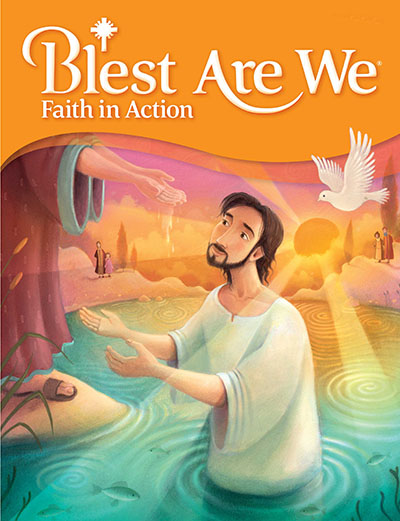 Blest Are We Faith in Action - School Edition Grades K-8
Blest Are We Faith in Action - School Edition Grades K-8
The Blest Are We Faith in Action religious education program engages children, youth, and their families in learning what Catholics believe, how Catholics worship, how Catholics pray, and how Catholics live. Our technology-enhanced learning resources, including eGuides, eBooks, eAssessments, and online chapter reviews, expand learning opportunities for students and flexibility for teachers.
Students will enjoy interactive connections with their textbooks, while teachers will find a variety of useful content for helping students on their formative journey of faith.
Blest Are We Faith in Action offers:
- Faith in Action pages for each chapter, establishing a strong connection to Catholic Social Teaching
- Redesigned Take Home pages, supporting families in the faith formation of their children
- Increased focus on children with special learning needs, addressing practical ways to adapt lessons
- Training Videos for Teachers, eBooks, eAssessments, Family Resources, Catholic Resources, Saints Resources, Lectionary Resources, and more!
Pagination
Latest
Categories
Archives
- February 2015 (2)
- March 2015 (2)
- April 2015 (5)
- May 2015 (3)
- June 2015 (6)
- July 2015 (3)
- August 2015 (5)
- September 2015 (5)
- October 2015 (4)
- November 2015 (2)
- December 2015 (1)
- February 2016 (2)
- March 2016 (1)
- April 2016 (2)
- May 2016 (2)
- July 2016 (2)
- August 2016 (2)
- September 2016 (1)
- October 2016 (5)
- November 2016 (1)
- December 2016 (3)
- January 2017 (2)
- February 2017 (3)
- March 2017 (2)
- April 2017 (1)
- June 2017 (2)
- July 2017 (2)
- August 2017 (1)
- April 2018 (1)
- October 2018 (2)
- December 2018 (2)
- February 2019 (3)
- March 2019 (2)
- April 2019 (2)
- May 2019 (3)
- June 2019 (1)
- July 2019 (16)
- August 2019 (8)
- March 2020 (4)
- April 2020 (6)
- May 2020 (8)
- June 2020 (7)
- July 2020 (5)
- August 2020 (7)
- September 2020 (4)
- October 2020 (5)
- November 2020 (9)
- December 2020 (11)
- January 2021 (10)
- February 2021 (8)
- March 2021 (5)
- April 2021 (4)
- May 2021 (4)
- June 2021 (5)
- July 2021 (2)
- August 2021 (3)
- September 2021 (4)
- October 2021 (4)
- November 2021 (2)
- December 2021 (5)
- January 2022 (4)
- February 2022 (4)
- March 2022 (9)
- April 2022 (7)
- May 2022 (9)
- June 2022 (12)
- July 2022 (7)
- August 2022 (10)
- September 2022 (9)
- October 2022 (11)
- November 2022 (8)
- December 2022 (7)
- January 2023 (2)
- February 2023 (10)
- March 2023 (9)
- April 2023 (10)
- May 2023 (8)
- June 2023 (4)
- July 2023 (3)
- August 2023 (2)
